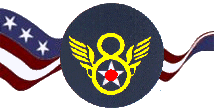
 |
|

HISTORY:
Constituted as 384th Bombardment Group (Heavy) on 25 Nov 1942. Activated on 1 Dec 1942. Trained for combat with B-17's. Moved to England, May-Jun 1943, and assigned to Eighth AF. Functioned primarily as a strategic bombardment organization, concentrating its attacks on airfields and industries in France and Germany. Targets included airdromes at Orleans, Bricy, and Nancy; motor works at Cologne; a coking plant at Gelsenkirchen; an aircraft component parts factory at Halberstadt; steel works at Magdeburg; and ball-bearing plants at Shweinfurt. Made a damaging raid on aircraft factories in central Germany on 11 Jan 1944 and received a DUC for the action. Took part in the campaign of heavy bombers against the German aircraft industry during Big Week, 20-25 Feb 1944. Received another DUC for the mission of 24 Apr 1944 when the group, although crippled by heavy losses of men and planes, led the 41st Wing through almost overwhelming opposition to attack an aircraft factory and airfield at Oberpfaffenhofen. The group also bombed ports, communications centers, oil facilities, and cities, attacking such targets as oil storage plants in Leipzig and Berlin, ports at Hamburg and Emden, and marshalling yards at Duren and Mannheim. At times it flew interdictory and support missions. Attacked installations along the coast of Normandy prior to and during the invasion in Jun 1944 and then bombed airfields and communications beyond the beachhead. Supported ground troops during the breakthrough at St Lo, 24-25 Jul, by bombing enemy strong points just beyond Allied lines. Hit tank and gun concentrations north of Eindhoven to assist the airborne assault on Holland in Sep. Struck enemy communications and fortifications during the Battle of the Bulge, Dec 1944-Jan 1945. Aided the Allied assault across the Rhine in Mar 1945 by attacking marshalling yards, railroad junctions, and bridges to cut off enemy supplies. Remained in the theater after the war as part of United States Air Forces in Europe. Carried American soldiers to Casablanca for return to the US, returned Greek soldiers to their homeland, and moved Allied troops to Germany. Inactivated in France on 28 Feb 1946.
Redesignated 384th Bombardment Group (Very Heavy). Allotted to the reserve. Activated on 16 Jul 1947. Inactivated on 27 Jun 1949.
Squadrons:
318th: 1947-1949.
339th: 1947-1949.
544th: 1942-1946; 1947-1949.
545th: 1942-1946; 1947-1949.
546th: 1942-1946.
547th: 1942-1946.Stations:
Gowen Field, Idaho, 1 Dec 1942
Wendover Field, Utah, 2 Jan 1943
Sioux City AAB, Iowa, c. 3 Apr-9 May 1943
Grafton Underwood, England, Jun 1943
Istres, France, c. Jun 1945-28 Feb 1946.
Nashville Mun Aprt, Tenn, 16 Jul 1947-27 Jun 1949.Commanders:
Col Budd J Peaslee, 2 Jan 1943
Col Lucius K Lacey, c. 6 Sep 1943
Col Dale O Smith, 23 Nov 1943
Lt Col Theodore E Milton, 24 Oct 1944
Lt Col Robert W Fish, 17 Jun 1945
Lt Col Lloyd D Chapman, 18 Oct 1945-Feb 1946.Campaigns:
Air Offensive, Europe; Normandy; Northern France; Rhineland; Ardennes-Alsace; Central Europe.
Decorations:
Distinguished Unit Citations: Germany, 11 Jan 1944; Germany, 24 Apr 1944.
Insigne:
Shield: Azure, between two cloud formations in chief and one in base throughout proper, five stars, one, two, and two or, the one in chief emitting a ray to each star of the like voided azure, and a lightning flash palewise to base point gules fimbriated argent, all within a diminutive border of the last. Motto: Keep The Show On The Road. (Approved 9 Apr 1958.)
Group Web Site:
http://www.384thbombgroup.com/